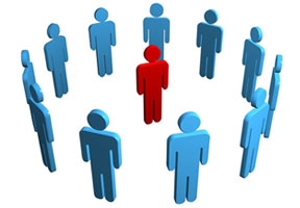Research project
Inclusion and exclusion
How do inclusion and exclusion affect people?
- Contact
- Frank Doolaard

People are social animals, with a strong need to belong to groups. This need to be included in groups and interact with others is considered fundamental to what it means to be human. Inclusion has been shown to have many benefits, for individuals' well-being and engagement as well as for their contexts (such as the workplace), and for minorities as well as majorities. Inclusion in groups is understood to have two dimensions: belonging and authenticity. People need to feel they are part of the group and that they can be their authentic selves in it.
Challenges of inclusion for deviating individuals
For people who deviate from group norms, for example because they look, think, or act differently in some way, a sense of inclusion can be harder to achieve. This may be because other group members willingly or unwillingly exclude them, or because they exclude themselves. When individuals are excluded, they feel hurt and experience negative emotions and distress. This aversion to being excluded is so strong, that people typically respond quite intense even to subtle signs of exclusion by others.
Understanding exclusion and its motivations
To understand exclusion it is important to consider not only the victim, but also the actors: i.e., the people or groups that exclude others. When people reject or ignore others, they too typically consider this an aversive experience – perhaps because people generally do not want to hurt others. Still, exclusion occurs quite frequently.
For example, people may ignore or reject others to punish them during conflicts, or to make them conform to the group. Also, people may reject low-performing or dysfunctional group members to increase their group’s performance. Exclusion can also be less willfully, for example when it is inevitable (e.g., when job candidates have to be rejected), or normative, (e.g., neglecting other travelers in public transport), or when it happens by accident (e.g., when people do not hear someone addressing them). Still, as people are really sensitive to being excluded, all these examples of exclusion can be rather hurtful for the victim.
Large-scale exclusion and interventions
Besides these rather small-scale examples of intragroup exclusion, at a larger scale feeling excluded or sensing a lack of inclusion is an important societal problem. Belonging to certain (minority) groups or categories can make people experience exclusion on the basis of their group membership. For example, when people are excluded on the basis of their gender, sexual orientation, or ethnicity. In these cases, creating a sense of commonality or inclusion can function as an intervention for inter-group discrimination and conflict. Such inclusion can be based on common goals or common identity.
Dual identity and inter-group harmony
An example of a common identity is a national identity that binds together the different ethnic groups living in a country. A common in-group identity works particularly well when it is combined with a sustained identification with the underlying sub-groups. An example of such a “dual identity” are Moroccan people living in the Netherlands identifying themselves as “Moroccan-Dutch”. Stressing commonalities between groups, but simultaneously respecting the difference between them, is a particularly fruitful way for creating inter-group harmony.
Safeguarding inclusion in diverse societies and organizations
As societies and organizations are becoming increasingly diverse, safeguarding the inclusion of specific groups of people is also becoming increasingly important. Understanding when and why actors include and exclude others, and the impact this has on victims, brings us one step closer in preventing vulnerable groups and individuals from feeling excluded.
